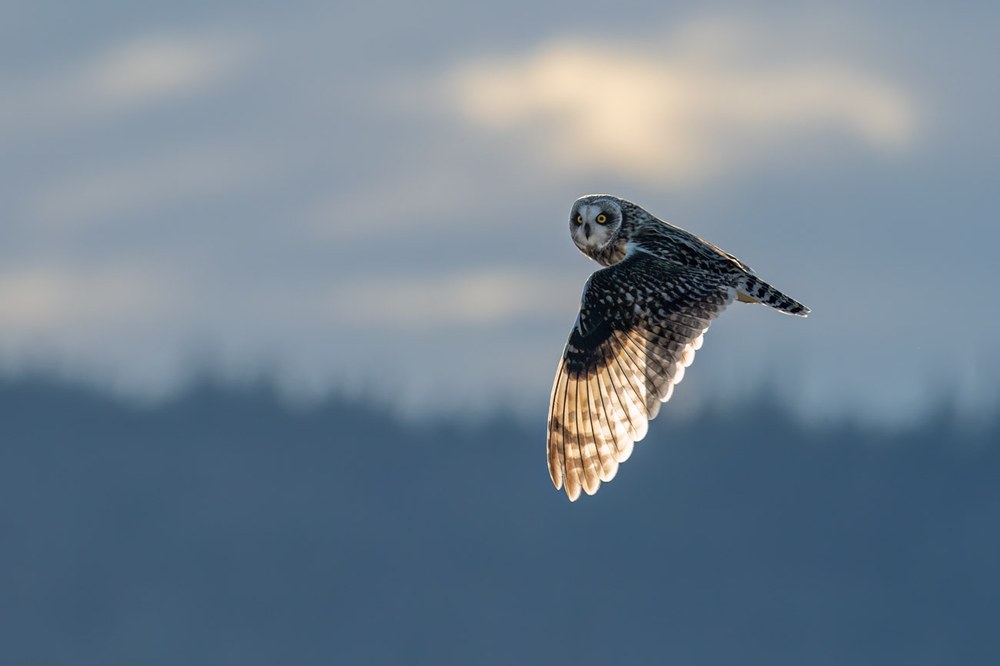
It was early February 2021, and Seattle had been darkened by overcast and rainy skies for weeks. Even worse, we were eleven months into the pandemic, and I was feeling isolated. Birds in my yard had been my only physical companions throughout Covid. Other than my two sisters I’d visited in Pennsylvania, I’d not been hugged or, for that matter, even had a handshake since the previous March. I generally don’t mind solitude, but that degree of isolation felt far different.
My spirits improved when The Mountaineers published guidelines for us to begin leading a few outings. Many requirements were put in place to protect leaders and participants from exposure to Covid. At first I was resistant, but then with one vaccine in my shoulder, I took the plunge.
I scheduled a birding trip to Western Skagit County for late February, limiting the participants to four. With Covid, we would have to drive ourselves. Normally we carpool with three passengers in each car - this gives people a chance to hang out together in between birding stops. The roster filled within one minute of opening. By early afternoon, we’d had a good day, finding swans, geese, sparrows, gulls, hawks, and plenty more.
We stopped then to walk along the dike at Rawlins Road. A fleeting Northern Shrike was a good find. Several sparrows flitted and chirped, then a participant spotted a bird flying in the distance. It was like an overgrown butterfly, with long gentle wing flaps and slow flight, almost as if it should just drop out of the sky. A Short-eared Owl was coming our way, one of the most sought-after birds in the Pacific Northwest. It was there in mid-afternoon, of all times. It came closer and closer, eventually circling us several times. The owl dropped for a possible mouse (no luck), landed for a minute on a log, and then began its slow quartering of the marsh again. I looked at my group; all spread out, everyone was transfixed by this show. The bird performed for an hour before flying west. No words could describe what had just happened or how it had raised our spirits. I offered to take them to one more spot, but we all agreed that nothing could top this. We left separately, reflecting on how this bird had enlivened us. We still talk about that experience today.
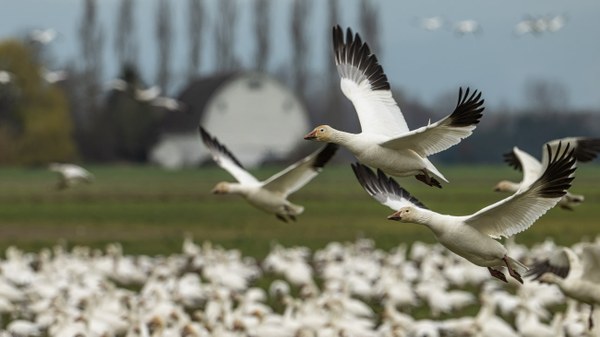 A family of Snow Geese rise from a feeding flock to land in a new grass patch, Fir Island.
A family of Snow Geese rise from a feeding flock to land in a new grass patch, Fir Island.
Our birding groups expanded as more people were vaccinated and Covid began to be controlled. During one trip we found a place where Snow Geese were grazing. Family groups of three, four, and five would fly up, move a few hundred yards, and drop back to the ground. At one point the mass, several thousand strong, took off. I thought they were leaving, but no, they circled and landed close by. Incredibly, these birds flew here from Wrangel Island in the Chukchi Sea of Russia, where they bred and raised their young. In April the flock will fly more than 2,400 miles back there to nest again. Occasionally, one here in Washington will become separated and fly back and forth cackling, eventually finding its family. Companionship is important to many in the natural world, too. One can’t help but have their spirits raised by watching these birds, listening to them chatter, and witnessing their athleticism.
Slowing down enough to see the little things, like mosses and lichens, can improve one’s outlook on life and help establish a deeper connection to the natural world. Several years ago, before Covid, my friend Gary planned a Mountaineers Naturalist trip to Old Sauk Trail. Just two days before our February outing, Puget Sound received heavy snow and he canceled the trip over concern for road conditions. Once the roads improved, Gary and I went on our own and found nature’s beauty to be just what our souls needed on those short days. We ate lunch on frozen rocks beside the Sauk River and found mosses. The soft colors of the running water created a kaleidoscope. We both focused on photography, looking deeply at mosses, ice, and water; sharing discoveries, perspectives, and recognizing the beauty that is everywhere if one takes the time to look.
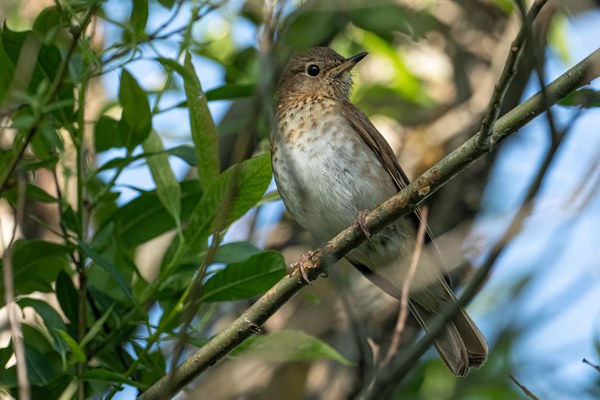 Swainson's Thrush, Marymoore Park.
Swainson's Thrush, Marymoore Park.
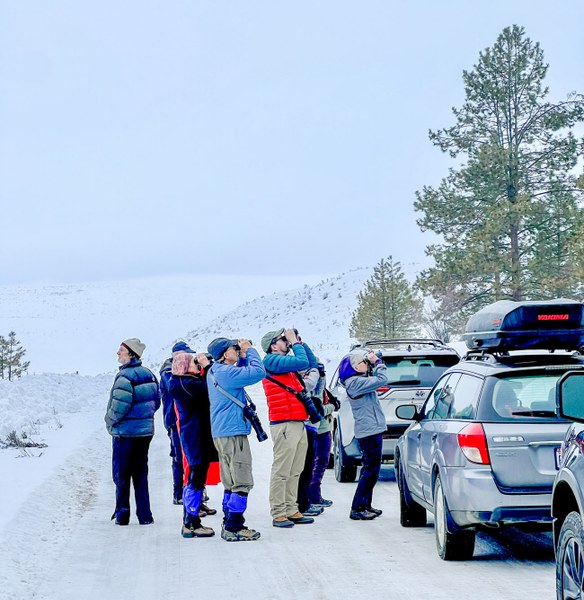 A group birding in the Okanogan Highlands. Photo by Becky Andrade.
A group birding in the Okanogan Highlands. Photo by Becky Andrade.
The transformative power of nature
There is something about nature that is so special; it brings us solace, relaxation, and, maybe most importantly, a sense of awe. One can’t help but be humbled when one realizes what different animals do to survive. Sometimes when I’m out with a group in winter, I’ll mention birds we might see at that place in the summer. For example, the Swainson’s Thrush we hear singing so beautifully on summer hikes are in either Central America or the Andes of South America during the winter, depending on whether they breed west or east of the Cascades.
Or that the miniature Rufous Hummingbird that dazzles everyone with its acrobatics and tenacity migrates in a loop, going south through the Rockies to winter in Mexico and then back up the Sierras and Cascades to summer here. Even some of our winter residents make incredible migrations. The Northern Shrike and Rough-legged Hawk come here from Canada to spend the winter with us. This is their “beach,” their winter retreat. These creatures aren’t our birds, but rather the world’s. Thinking about their lives can’t help but build empathy and patience for our own.
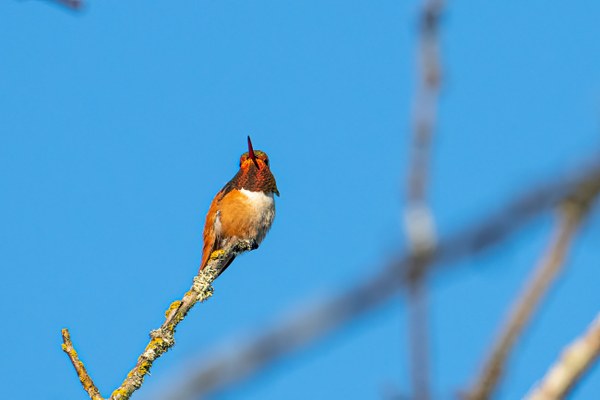 Male Rufous hummingbird, Marymoore Park.
Male Rufous hummingbird, Marymoore Park.
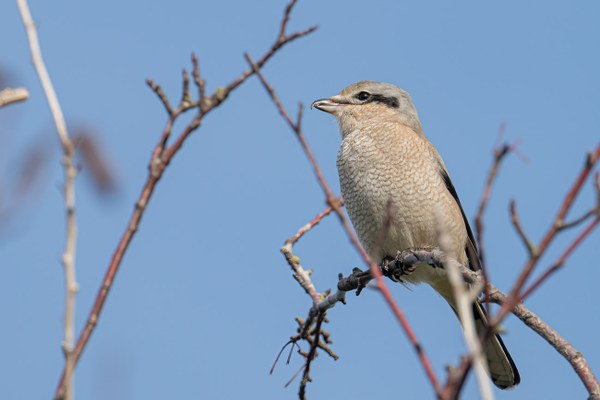 Northern Shrike, Fir Island.
Northern Shrike, Fir Island.
Western society is so focused on “me” and what is good for “me, me, me.” Looking at nature can build an appreciation for the life of native plants and animals and their habitats. For example, the adaptations of alpine plants on Burrows Mountain to withstand winds, cold, and short growing seasons can’t help but amaze us. Life is incredible. Remember the next time you are hiking and hear the sweet musical song of a Swainson’s Thrush that this bird weighs the equivalent of 48 dried garbanzo beans, has a 10-inch wingspan, and yet flies all on its own from Washington to Latin America. The next time I am sweating and cursing that climb into the Alpine Lakes Wilderness, I will remember that 200 million years ago, I’d have had to go to where Spokane is now to find the North American continent. To make this state, four waves of island crusts have accreted since then. The rock under your feet on Mt. Rainier’s Sourdough Ridge only solidified a few hundred thousand years ago when lava flowed between two Pleistocene glaciers. This world is magnificent, and we humans are an insignificant part of it in time or life. We may destroy the earth’s ability to support our lifestyle, but maybe with a broader view, our humbled selves will change things.
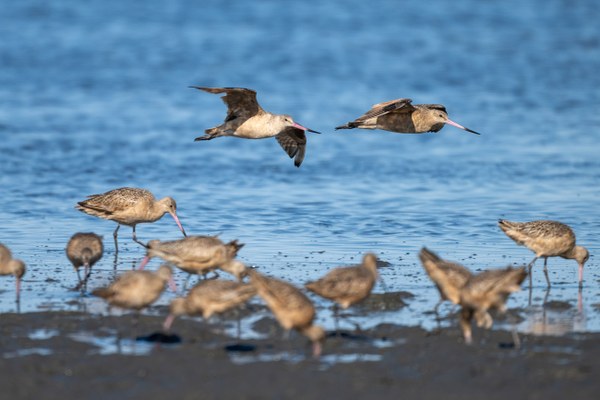 Marbled godwit, Bottle Beach.
Marbled godwit, Bottle Beach.
Last fall, I led a Mountaineers trip to the coast to look for shorebirds. We’d been sitting on the beach waiting for the tide to push the feeding birds toward us when two photographers came along. First, they walked out onto the mudflats just to our left, flushing the birds a couple of times, then came behind us, without acknowledging us, and walked again out to the flats. I asked them to show a little courtesy and etiquette. Neither thought I had the right to interfere with their quest for the perfect shot, let alone that their behavior increased the energy needs of these birds during their migration. So what? To me, one of the most important things the Naturalist program can share with folks is a sense of awe for the life of the animals and plants we have right here in the Pacific Northwest. Perhaps it will encourage folks to stay on the trail, show more courtesy to others, and have respect for living things and this planet.
There is something special about recognizing and identifying different organisms, and having a greater understanding of this world, its geology and ecology. Naming things shows a level of respect and is a powerful show of support; recognizing living things as being different and unique, so said Robin Wall Kimmerer, the writer and botanist. Noticing the land and its inhabitants can lead to a deeper connection to our planet and might allow us to receive nature’s gifts.
Providing an environment for people to enjoy and learn about nature is the greatest reward I can have. It is all about storytelling and offering a place where all questions are welcome, where participants can reach their goal of seeing, identifying, learning, and maybe most importantly, receiving solace from the natural world.
This blog was updated to reflect a republication in our winter 2024 issue of Mountaineer magazine. To view the article in magazine form and read more stories from our publication, visit our magazine archive.
Add a comment
Log in to add comments.Loved this article. You captured the joy of being a naturalist so artfully. Thank you!
Tom - Thank you for writing and sharing your very thoughtful ruminations. Reading your essay this morning resonated deeply for/with me, and is a gift I will carry with me. And kudos for the exquisite photos!
Wow, what a shot of tecolote! Your post makes me miss the outdoors in the NW during winter, but not enough to surrender my Mexican perch. Thank you for being a messenger for wildlife!
I loved this article & the photographs. Thank you!
This is a beautifully written article, Thomas. Your encouragement to slow down and look more closely, name things, and soak up the joys of nature is refreshing.
 Thomas Bancroft
Thomas Bancroft